Something went wrong!
Hang in there while we get back on track
Best attractions in Florence

Santa Maria del Fiore is a masterpiece of Renaissance art and architecture. With its magnificent red-tiled dome designed by Brunelleschi and a facade that delights in shades of pink, white, and green marble, the Duomo commands the city's landscape. Build between 1296 and 1436, it claims the title of the third-largest cathedral in Europe, surpassed only by St. Peter’s in Rome and the Duomo in Milan. Inside, the cathedral shelters artistic treasures from Michelangelo to Donatello, alongside stunning frescoes.

This world class art gallery houses the largest collection of Italian Renaissance art in the world and is a premier destination for art enthusiasts. Located in the magnificent Palazzo degli Uffizi in over 100 rooms, masterpieces by Botticelli, Michelangelo, and Leonardo da Vinci astonish millions of visitors every year. The Medici family's legacy is omnipresent, their collection a gift to Florence ensuring the city's eternal connection to the Renaissance.

The highlight of this art museum is Michelangelo's David, his most challenging project. Carved from a single, imperfect block of marble, this iconic statue captivates with its intricate details and lifelike expressions.

The Palazzo Vecchio, with its imposing structure and commanding presence, is one of Florence's top sights. This historic building serves as the city's town hall and casts its gaze over the bustling Piazza della Signoria, an iconic square adorned with a replica of Michelangelo's David.

Spanning the Arno River in Florence with its medieval stone arches, the Ponte Vecchio is adorned with a vibrant trail of jewellery and souvenir shops. The iconic bridge connects the city's cultural heartbeats:
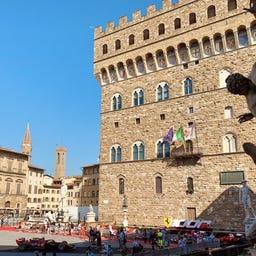
The Piazza della Signoria is the historic and vibrant heart of Florence, located in front of the imposing Palazzo Vecchio. This bustling square houses an impressive collection of statues and monuments, resembling an open-air museum that attracts tourists from around the world. A visit to the piazza is essential for anyone visiting Florence.
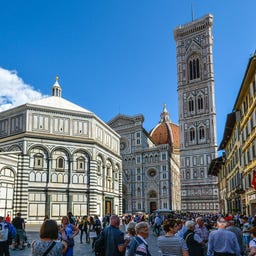
When visiting Florence, a stop at Piazza del Duomo is an absolute must – the heart of the city and a place filled with unique architecture. Dominating the square is the Cathedral of Santa Maria del Fiore, a masterpiece of Gothic architecture, whose iconic dome by Brunelleschi defines Florence's skyline.

The largest masonry dome in the world has been towering over the Cathedral of Santa Maria del Fiore in Florence since the 15th century and is considered one of the most important buildings in Europe since Roman times. With a height of 116 meters and a weight of 37,000 tons, Filippo Brunelleschi created an architectural masterpiece here between 1420 and 1436, which did not rely on traditional wooden scaffolding. The construction, consisting of two shells, impresses not only with its perfect proportions based on the Golden Ratio but also with the magnificent frescoes of the Last Judgment inside.
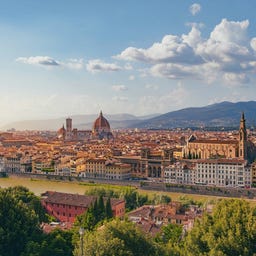
Piazzale Michelangelo is undeniably one of the most popular viewpoints in Florence. Perched on a hill south of the Arno, it offers stunning panoramic views of the city, including the Duomo, Ponte Vecchio, and the Tuscan hills. At sunset, crowds gather to witness the Renaissance city bathed in golden light.

The Basilica di Santa Croce, located in the heart of Florence, is an impressive landmark and the largest Franciscan church in Italy. Known as the "Pantheon of Florence," it houses the tombs of famous figures such as Michelangelo, Galileo Galilei, and Machiavelli. The basilica's facade, a masterpiece of neo-Gothic style, is elegant and beautiful. Inside, you will find magnificent frescoes by Giotto depicting the life of Saint Francis, as well as Donatello's splendid "Deposition from the Cross."

The Palazzo Pitti, just a stone's throw from the Ponte Vecchio, was once the residence of the Medici and now houses some of Florence’s most important museums.
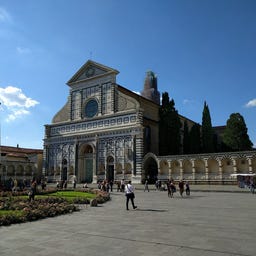
The Basilica di Santa Maria Novella is one of the most significant churches in Florence and a masterpiece of Gothic and Renaissance. It is located at Piazza Santa Maria Novella, directly opposite the train station of the same name. The magnificent facade, designed by Leon Battista Alberti, was completed in 1470. The complex includes the church, two cloisters, and several monastic buildings.

The Central Market (mercato centrale) is a two-level, indoor food market and part of the larger San Lorenzo market.

In front of you stands one of the most famous sculptures in art history: the 5.20-meter tall David made of white Carrara marble, created by Michelangelo in the early 16th century. The statue depicts the biblical hero at the moment of intense concentration before his battle with Goliath - a revolutionary representation without the severed head of the giant.

In the magnificent Cappelle Medicee, which were built in the 16th and 17th centuries as an extension of the Basilica San Lorenzo, you will find the most impressive tombs of the powerful Medici family. The New Sacristy, designed by Michelangelo, houses monumental tombs, while the octagonal Princes' Chapel impresses with its valuable marble and semi-precious stone work, as well as the second-largest dome in Florence.
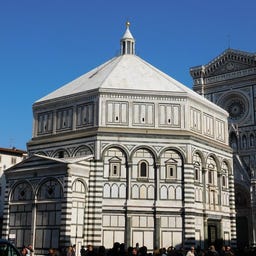
Directly opposite the impressive Cathedral of Santa Maria del Fiore stands the octagonal Baptistery, one of the oldest places of worship in Florence from the 11th century. The three bronze doors - including the famous "Gates of Paradise" by Lorenzo Ghiberti - are considered masterpieces of the Italian early Renaissance. Inside, you will find an impressive dome adorned with golden mosaics from the 13th century, depicting the Last Judgment and biblical scenes. Not only countless Florentines were baptized here, including Dante Alighieri, but also knights and poets were inaugurated into their offices.
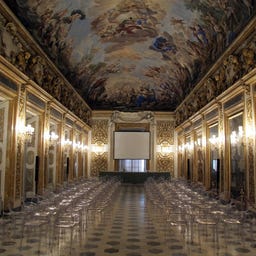
In the heart of Florence stands the Palazzo Medici Riccardi, the first city palace of the powerful Medici family from the 15th century. Designed by Michelozzo between 1444 and 1452, this Renaissance building impresses with its cubic shape, characteristic rusticated facade, and an elegant courtyard adorned with Corinthian columns.
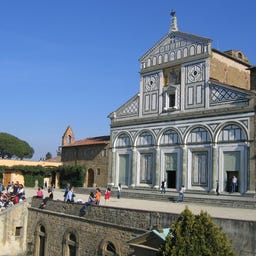
High above Florence stands the Abbazia di San Miniato al Monte, one of the most beautiful examples of Romanesque architecture in Tuscany, whose construction began in 1018 under Bishop Alibrando. In the majestic basilica, you can discover one of the oldest functioning sundials in Europe and a unique zodiac marble floor from the 13th century, which lights up in the sign of Cancer during the summer solstice.
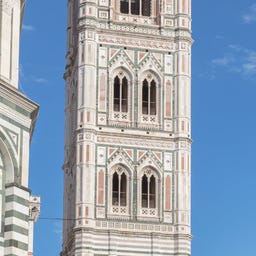
The 85-meter tall Campanile is the striking bell tower of the Cathedral of Santa Maria del Fiore in Florence. Its construction began in the late 13th century under Arnolfo di Cambio and was completed in 1359 by Francesco Talenti. Named after its second architect, Giotto di Bondone, the tower impresses with its façade made of white, green, and red marble, as well as intricately designed reliefs and statues, the originals of which can be admired today in the Museum of the Opera del Duomo. After climbing 398 steps, you are rewarded at the top with a magnificent panoramic view of Florence—a challenge that around 290,000 visitors undertake each year.
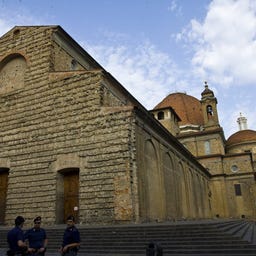
The Basilica di San Lorenzo is one of the oldest churches in Florence, founded in the 4th century. As the family church of the powerful Medici family, it underwent a comprehensive reconstruction in Renaissance style starting in 1418 under Filippo Brunelleschi, whose innovative design became a model for many other churches.
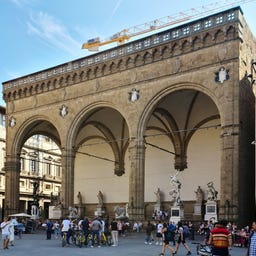
The Loggia della Signoria is an impressive Gothic colonnade located right next to the Palazzo Vecchio in the heart of Florence. It was built between 1376 and 1382 as a meeting place for the Florentine Republic. Under Grand Duke Cosimo I., it transformed in the 16th century into a publicly accessible sculpture gallery, which still houses significant masterpieces like Benvenuto Cellini's "Perseus" and Giambologna's "The Rape of the Sabine Women."

On the Piazza della Repubblica in the heart of Florence, you step right into the vibrant center of the city, where the most important roads intersected even during Roman times. The elegant pedestrian zone is lined with magnificent palaces, including the Palazzo Levi with its historic coffee houses and the impressive Palazzo dell'Arcone featuring its distinctive triumphal arch.
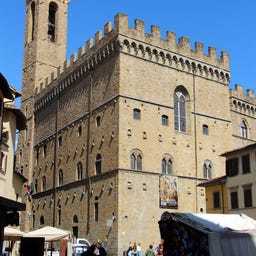
In the former city palace Palazzo del Bargello, you will find one of the most significant sculpture collections of the Renaissance in the world. Here, you can admire masterpieces by Michelangelo, Donatello, and other greats of Italian art history, including both versions of Donatello's famous "David" in marble and bronze.
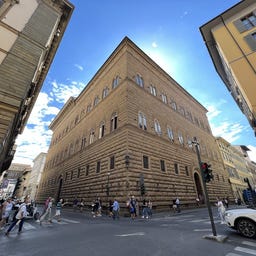
The Palazzo Strozzi is one of the most important Renaissance palaces in Italy, built between 1489 and 1538 as a powerful statement by the Strozzi family, who were rivals of the Medici.
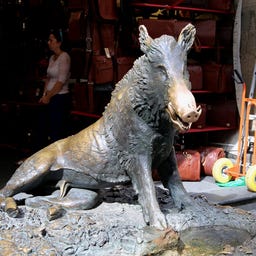
At the Loggia del Mercato Nuovo in Florence, you’ll find one of the city’s most beloved traditions: the "Porcellino," a bronze boar with a shiny, polished nose that gleams from countless touches. The statue you see today is a detailed replica of the bronze work created by Pietro Tacca in the 17th century, which is based on an ancient marble sculpture.
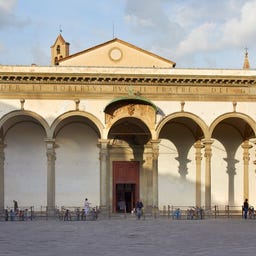
The Basilica della Santissima Annunziata is the most important Marian shrine in Florence and impresses with its blend of Renaissance and Baroque architecture. Built by the Servites in the 13th century, the church owes its significance to a miraculous Annunciation fresco from 1252 that is venerated for its wonders.
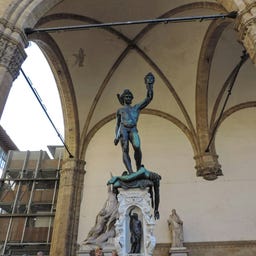
Under the magnificent Loggia dei Lanzi in Florence, you will find one of the most impressive bronze sculptures of the 16th century: Benvenuto Cellini's monumental Perseus, triumphantly presenting the severed head of Medusa. The statue, over 5 meters tall and created between 1545 and 1554 on the commission of Duke Cosimo I de' Medici, is considered a masterpiece of Italian Mannerism and captivates with its fascinating details - including a hidden self-portrait of the artist on the neck of Perseus.
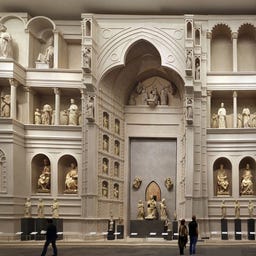
At the Museo dell'Opera del Duomo, you will find one of the most important collections of Gothic and Renaissance sculptures in Italy, featuring masterpieces by Michelangelo and Donatello. A well-designed tour takes you through 28 rooms across three floors and 6,000 square meters, showcasing the most precious art treasures of the Florentine Duomo complex since 1891.
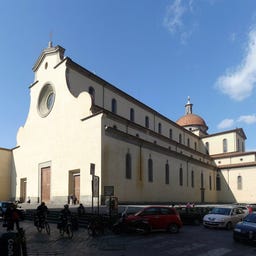
The Basilica di Santo Spirito in the Oltrarno district is one of the most significant churches in Florence and was the last major project designed by the Renaissance architect Filippo Brunelleschi. Inside, you'll find three nave sections separated by columns and 38 intricately designed side altars, while the simple façade dominates the square of the same name.
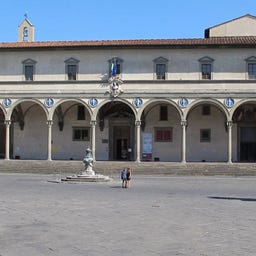
The Spedale degli Innocenti at the Piazza della Santissima Annunziata is one of the first orphanages in Europe and is considered a milestone of Renaissance architecture. The building, designed by Filippo Brunelleschi, with its characteristic columned loggia, was opened in 1445 and housed abandoned children for centuries, who could be left by their parents anonymously through a special wheel.
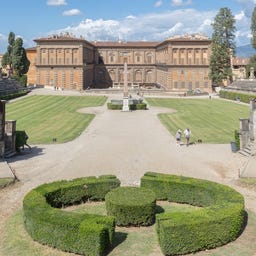
Behind the magnificent Palazzo Pitti lies one of the most significant Italian gardens in the world: the Giardino di Boboli, a 45,000 square meter open-air museum filled with sculptures spanning two millennia. Established in the 16th century by the Medici family, this park has been continuously expanded over the centuries and now impresses with its artistically designed terraces, hidden grottos, and majestic fountains like the Fontana dell'Oceano.
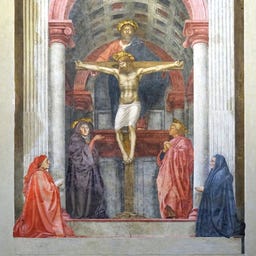
In the Basilica di Santa Maria Novella in Florence, you will encounter the "Trinità," one of the groundbreaking masterpieces of the Italian Early Renaissance. The monumental fresco by Masaccio, created between 1425 and 1428, impresses with its revolutionary perspective and astonishing depth effect.
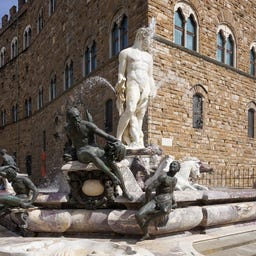
Right next to the impressive Palazzo Vecchio stands Florence's first monumental fountain, commissioned by Cosimo I de' Medici in the mid-16th century. The Neptune Fountain, created by Bartolomeo Ammannati, captivates with its central figure made of white Carrara marble, surrounded by four horses and musical Tritons.
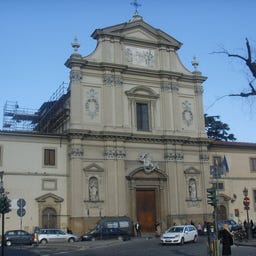
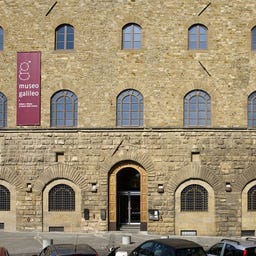
In the historic Palazzo Castellani from the 11th century, you will find one of the most significant collections of scientific instruments in the world. The collection originates from Cosimo I. de' Medici and has been expanded over centuries by the Medici and Lorraine dynasties.
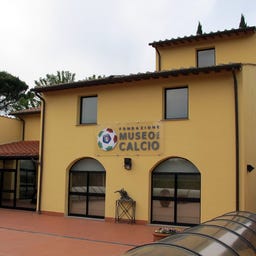
In the Hall of Fame of Italian Football in Coverciano, Tuscany, the history of Italian football has been kept alive since 2011. Initiated by the Italian Football Federation (FIGC), this hall of fame honors deserving individuals each year in various categories—from players and coaches to referees, with female footballers being recognized since 2014.
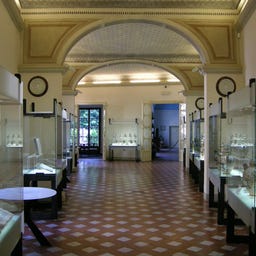
In the oldest pharmacy in Europe, which has been continuously operating since the 14th century, you can expect a unique journey through the world of historical perfume and healing arts. The magnificent Officina was established in 1612 as the pharmacy of the Dominican monks and developed under the patronage of Ferdinando II de' Medici into a world-renowned manufactory, with products exported as far as India and China.
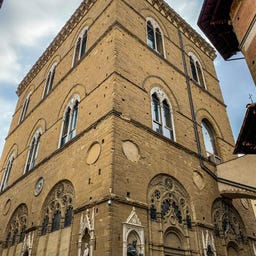
In the Chiesa di Orsanmichele, you will experience a fascinating piece of Florentine history, as what began as a small monastery in the 8th century was later transformed into a grain hall and eventually into a magnificent guild church.
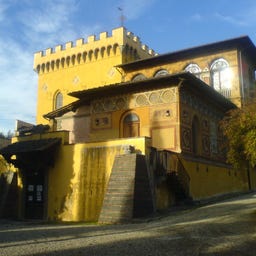
At the Museo Stibbert, you will find one of the most significant weapon collections in Europe, featuring over 50,000 exhibits collected by the English art collector Frederick Stibbert in the late 19th century. The magnificent villa, designed in an eclectic style, houses not only an impressive collection of 16,000 armors but also masterpieces by Botticelli, Crivelli, and Brueghel the Younger.

The Chiesa di Ognissanti is one of the most significant churches in Florence and has a rich history that began in the 13th century with the Humiliati order. In this single-nave church, you can still find remarkable artworks today, such as the famous crucifix by Giotto and frescoes by Botticelli and Ghirlandaio from the 15th century.
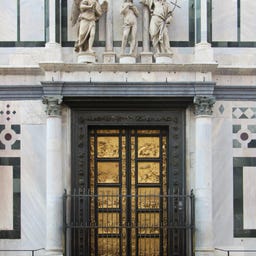
The Porta del Paradiso, the eastern bronze door of the Baptistery of Florence, is considered one of the most significant works of art from the early Renaissance. The goldsmith and sculptor Lorenzo Ghiberti created this completely gilded masterpiece between 1425 and 1452, earning its heavenly name from Michelangelo.
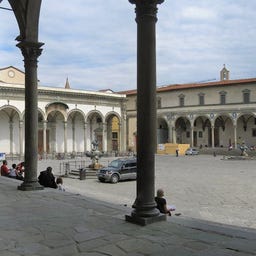
On the Piazza della Santissima Annunziata, you will find one of the most harmonious squares of the Florentine Renaissance, attracting pilgrims and visitors since the 13th century. The square, lined with arcades, is dominated by the magnificent Basilica della Santissima Annunziata and impresses with its symmetrical design featuring twin palaces.

With the Parco delle Cascine, you will discover Florence's largest public park, stretching over 160 hectares along the Arno River.
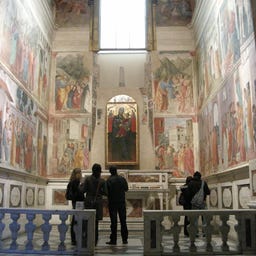
In the Basilica Santa Maria del Carmine, you will find one of the most significant masterpieces of the Early Renaissance: the Cappella Brancacci. The frescoes created by Masaccio, Masolino da Panicale, and Filippino Lippi between 1424 and 1428 tell the story of human redemption, from the expulsion from Paradise to the role of Saint Peter.
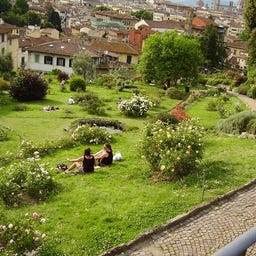
Just below the Piazzale Michelangelo lies the Rose Garden of Florence, created in 1865 by architect Giuseppe Poggi. Today, around 1,000 botanical species grow on several French-inspired terraces that offer a spectacular view of the city, including 350 historical rose varieties.

The powerful Fortezza da Basso, originally known as Castello Alessandria, has stood since the 16th century as an impressive example of Medici power within the city walls of Florence.

The Opera di Firenze, which opened in 2014, is Florence's most modern cultural temple and the main venue for the traditional Maggio Musicale Fiorentino. In the award-winning complex near the Parco delle Cascine, you can expect an opera house with nearly 1,900 seats, as well as the auditorium named after Zubin Mehta, which accommodates 1,200 visitors.
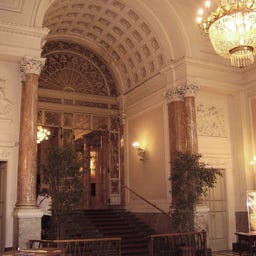
In the historic Teatro della Pergola, one of the oldest theaters in Italy, you can experience authentic theater art in an impressive neoclassical setting since 1656. The salmon-colored building, with its lavish atrium, monumental staircase, and traditional red velvet curtain, is considered the birthplace of melodrama and the later opera genre.

High above Florence stands the Fortezza di Santa Maria, also known as Forte Belvedere - an impressive fortress built in the 16th century by the architect Bernardo Buontalenti for the powerful Medici family. This star-shaped structure combines military strength with regal elegance and houses not only sophisticated defense systems but also a secret treasure room.
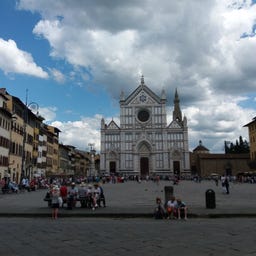
On the expansive Piazza Santa Croce, established by Franciscans in the 13th century, the majestic Basilica stands tall - the final resting place of Michelangelo, Galileo, and Machiavelli. The square, originally a river island and lined with magnificent noble palaces, evolved since the 14th century into the main venue for public festivities and tournaments in Florence.

In the historic center of Florence, which has been a UNESCO World Heritage Site since 1982, you will find a unique concentration of art and architecture from the 14th to the 16th century. Here, you can see world-famous landmarks like the Cathedral of Santa Maria del Fiore, the Palazzo Vecchio, and the Uffizi Gallery, as well as Michelangelo's David in the Accademia Gallery.
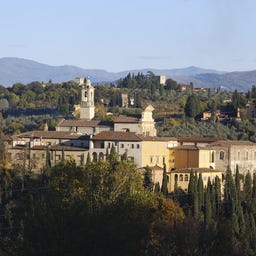
High above Florence, the Certosa di Firenze welcomes you, a former Carthusian monastery from the 14th century, founded by Niccolò Acciaiuoli and now inhabited by Cistercian monks.
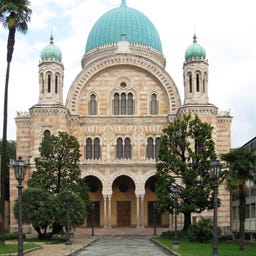
The magnificent synagogue of Florence, with its distinctive green dome, has shaped the city's skyline since 1882 and is an impressive example of Moorish architecture. Built of white travertine and pink plaster, the structure designed by Marco Treves not only features a prayer hall adorned with red and blue arabesques but also houses an exciting Jewish museum spread over two floors.
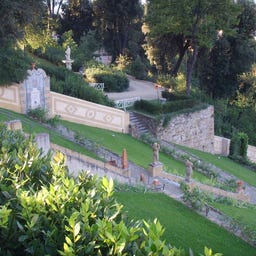
Hidden in the Oltrarno district of Florence, the Giardino Bardini awaits you with its historic garden that dates back to the 13th century. Here, on four hectares, you can discover a magnificent Baroque staircase leading to a belvedere with breathtaking views of the city, six ornate fountains, and a rustic grotto.

In the heart of Florence stands the Palazzo dello Strozzino, an impressive example of 15th-century Renaissance architecture. Built by the Strozzi family between 1450 and 1469, the palace captivates with its distinctive facade of rustic stonework and three large portals.
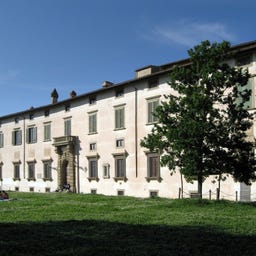
Northwest of Florence, you will find the Villa Medicea di Castello, one of the most significant Medici villas from the 14th century, which has been a UNESCO World Heritage site since 2013. The magnificent Renaissance garden, commissioned by Cosimo I de' Medici in 1538, is considered the second most beautiful after the Boboli Gardens and was named the most beautiful park in Italy in 2013.

High above Florence stands the Villa La Petraia, one of the most beautiful Medici villas in Tuscany and now a UNESCO World Heritage site.
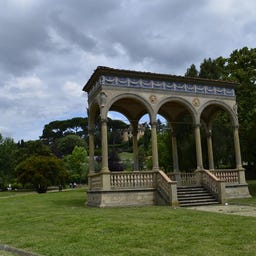
In the heart of Florence, you will find a green oasis at the Giardino dell'Orticultura, which has been maintained by the Società Toscana di Orticoltura since 1859. The centerpiece of the garden is the impressive Tepidarium - a 650-square-meter greenhouse made of glass and iron, built in 1880 according to the plans of architect Giacomo Roster.

In the Palazzo Davanzati, an impressive city palace from the mid-14th century, you experience authentic living of the Florentine upper class. The narrow, tall building with its characteristic stone facade was lovingly restored by Elia Volpi in 1904 after a tumultuous history and now houses the Museum of the Old Florentine House.

In the venerable Teatro Verdi, one of the largest theaters in Italy, you can experience classic operas and modern concerts in a historic setting with over 1,500 seats. The impressive building, designed by architect Telemaco Bonaiuti, opened in 1854 as Teatro Pagliano and is located on the site of a former prison that is 500 years old.

In the Basilica di Santa Maria del Carmine, you can admire one of the most significant artworks of the Early Renaissance: the famous Brancacci Chapel with its groundbreaking frescoes by Masaccio, Masolino, and Filippino Lippi. Founded in 1268, the church was completely rebuilt in the style of the 18th century after a devastating fire in 1771, while the characteristic unfinished façade has been preserved to this day.
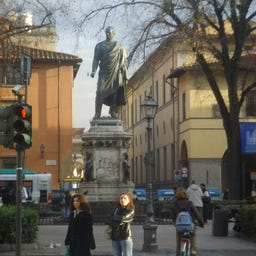
The Piazza San Marco in the northern part of the historic center of Florence was created in the mid-15th century under Cosimo il Vecchio, who had a church and a monastery built here for the Silvestrine Order. The square is lined with elegant buildings, including the Accademia di Belle Arti and central facilities of the University of Florence.
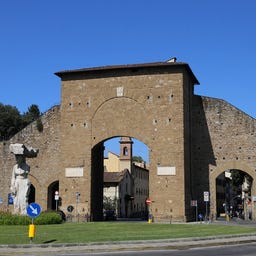
The Porta Romana, the southernmost city gate of the Florentine city wall, was likely built by Andrea Orcagna between 1328 and 1331 and served as an important entrance for travelers from Siena and Rome. In the 16th century, the impressive structure was lowered for protection against cannon fire, but it retained its massive wooden doors with intricate iron fittings.
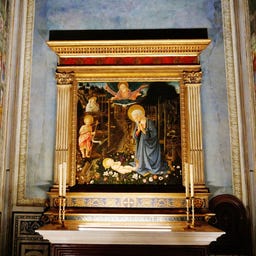
In the magnificent Palazzo Medici Riccardi, you will find one of the most intimate Renaissance chapels in Florence, the Cappella dei Magi. Completed in 1459, this private chapel of the Medici impresses with one of the most famous fresco cycles by the painter Benozzo Gozzoli, which winds around the viewer like a continuous procession.

In the Palazzo della Crocetta, dating back to the early 17th century, you will find one of the most significant archaeological collections in Italy, featuring treasures from four ancient cultures. The Etruscan section showcases masterpieces like the famous Chimera of Arezzo and the Arringatore, while the Egyptian collection is the second largest in the country. In the museum garden, you can explore accurately reconstructed Etruscan tombs, including the Tomba Inghirami from Volterra. Among the outstanding exhibits is the Vaso François, an impressive black-figure krater from the 6th century BC, and there are over 100,000 additional objects stored in the depots.

In the Basilica di Santa Croce, you will find one of the most influential buildings of Renaissance architecture: the Cappella Pazzi. This private chapel, commissioned by the powerful Pazzi family, was built starting in 1442 based on the designs of architect Filippo Brunelleschi and is considered his masterpiece today.

The Vasari Corridor is a 760-meter-long elevated passageway in Florence that connects the Palazzo Vecchio through the Uffizi and the Ponte Vecchio to the Palazzo Pitti. Commissioned in 1565 by Duke Cosimo I de' Medici, the corridor was built in just nine months and served as a secure passage for the Medici between their residences.

At the former Dominican monastery San Marco, you will find a unique combination of church, convent, and museum that tells the story of the close relationship between art and religion in Renaissance Florence. The complex, sponsored by Cosimo de' Medici, was remodeled in Renaissance style by architect Michelozzo between 1439 and 1444 and hosted significant figures such as the artist Fra Angelico and the preacher Girolamo Savonarola.
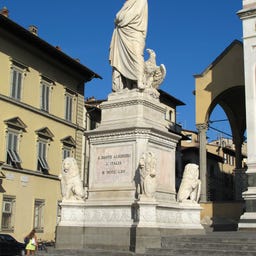
In the middle of Piazza Santa Croce, the impressive monument to Dante Alighieri stands tall, created by sculptor Enrico Pazzi from white Carrara marble between 1856 and 1865. The life-sized statue depicts the poet with a serious expression and a laurel wreath, holding the "Divine Comedy" in his right hand, accompanied by an eagle.
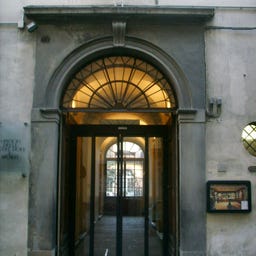
In the historic San Niccolò di Cafaggio Monastery, you will find one of the most significant restoration institutes in Italy, founded in 1588 by Ferdinando I. de' Medici as a workshop for hardstone inlays. The Opificio delle pietre dure now combines three functions under one roof: an internationally renowned restoration center, a school for restorers, and a museum showcasing the unique Florentine craftsmanship of "commesso."

The Palazzo Rucellai is considered one of the most significant examples of Florentine Renaissance architecture from the 15th century and was designed by Leon Battista Alberti for the wealthy merchant Giovanni Rucellai. The striking facade, with its uniform stone pattern, combines classical elements with medieval tradition and has had a lasting impact on civil architecture during the Renaissance.
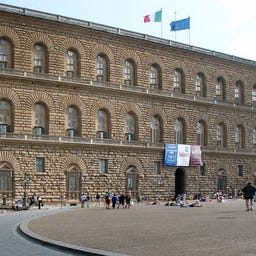
In the magnificent Palazzo Pitti, you will find one of Italy's most important art collections at the Galleria Palatina, shaped largely by the exquisite taste of the Medici family. In 28 richly frescoed rooms, there are around 500 masterpieces from the late Renaissance and Baroque periods, including highlights by Raphael, Titian, and Caravaggio.
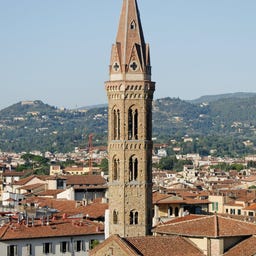
The Badia Fiorentina, one of the oldest churches in Florence, was founded in 978 by Hugo II of Tuscany and still shapes the skyline of the old town with its 70-meter-high bell tower. Throughout its eventful history, the abbey underwent a Gothic renovation by Arnolfo di Cambio in the 13th century and became an important center of humanism in the 15th century.
In the historic Café Paszkowski at Piazza della Repubblica, you dive into the cultural soul of Florence. This establishment, taken over by the Polish Paszkowski family in 1904, transformed from a Viennese beer house into an elegant Caffè Concerto, where literary greats like Gabriele D'Annunzio and Eugenio Montale would meet.

High above Florence stands the Villa Bardini, a magnificent estate from the 17th century that offers you one of the most beautiful panoramic views of the city. Originally designed by Gherardo Silvani, the building now houses a vibrant cultural center with changing exhibitions and the Annigoni Museum across four floors and 3,800 square meters.

The elegant Loggia del Mercato Nuovo in the heart of Florence was built between 1547 and 1551 under Cosimo I de' Medici as a covered marketplace for silk and precious goods. The colonnade designed by Giovanni Battista del Tasso in the Mannerist style is now mainly visited for its famous bronze sculpture, the Fontana del Porcellino - a wild boar whose snout tourists touch for good luck.
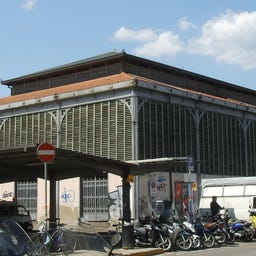
The historic Mercato di Sant'Ambrogio, built in 1873 by Giuseppe Mengoni, is one of the most authentic markets in Florence and a vibrant meeting place for locals. In the distinctive iron structure with its tall masonry base, you will find both a covered indoor area and outdoor stalls that offer fresh food and other goods daily, except on holidays.
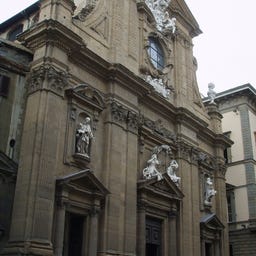
The Chiesa dei Santi Michele e Gaetano is the most significant Baroque building in Florence and has shaped the central Piazza degli Antinori since the 17th century. The history of the church dates back to the 11th century, but its current appearance is the result of a complete reconstruction between 1604 and 1701.

In the Sagrestia Nuova of the Basilica di San Lorenzo, you will find one of the most impressive tomb monuments of the Medici family, created by Michelangelo as both architect and sculptor starting in 1520.
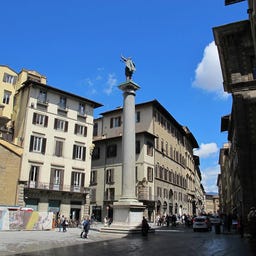
At Piazza Santa Trinita, historical power meets religious splendor: The Gothic basilica from the 11th century that gives the square its name dominates the area, while the majestic Colonna della Giustizia with its statue of Justitia reflects the generosity of Pope Pius IV.

Deep beneath the magnificent Santa Maria del Fiore lies a fascinating piece of Florentine history: the remains of the Chiesa di Santa Reparata, the city's original cathedral from the 4th to 6th century. In the archaeological excavations, which you can access through a passage in the right nave of the cathedral, you can admire early Christian mosaics and remnants of Roman houses, as well as discover the tomb of the famous architect Filippo Brunelleschi.
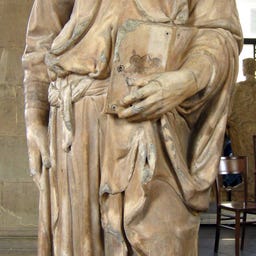
The majestic marble statue of San Marco in the Museo di Orsanmichele is one of the groundbreaking early works of the sculptor Donatello from the early 15th century. The 2.48-meter tall figure, depicting the Evangelist with a beard, toga, and an open book, was created between 1411 and 1413 from Apuan marble. As Donatello's first sculpture fully in the Renaissance style, it impressed even Michelangelo, who saw in it the ideal image of a virtuous person.
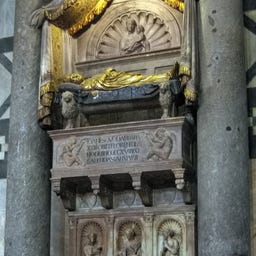
In the Baptistery of Florence, you will find the impressive tomb of the antipope Giovanni XXIII, a 7.32-meter tall masterpiece made of marble and gilded bronze from the early 15th century. The monument, created by Donatello and Michelozzo, depicts the controversial churchman in cardinal robes resting on a deathbed, covered by an elaborate marble canopy with a shell vault.
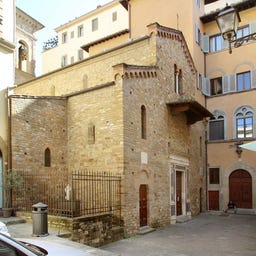
The Chiesa dei Santi Apostoli is one of the oldest churches in Florence, blending Romanesque and Renaissance architecture. Inside, you'll find impressive columns made of green marble and significant artworks, including pieces by Giorgio Vasari and a tabernacle by Andrea della Robbia from the 16th century.
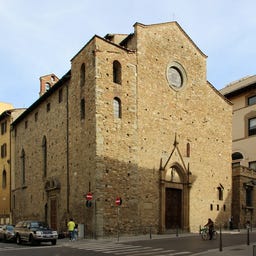
The Chiesa di Santa Maria Maggiore is one of the oldest churches in Florence, first mentioned in documents as early as 931. In its current form, the church presents an interesting mix of Gothic, Renaissance, and Baroque elements, with the Gothic portal and its Madonna statue particularly standing out.
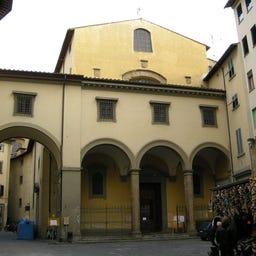
Right next to the Ponte Vecchio, you will discover the Chiesa di Santa Felicita, one of the oldest churches in Florence, with origins dating back to Roman times. The current Baroque structure from the 18th century impresses with its single-nave layout and barrel vault, housing significant artworks like Pontormo's "Deposition" in the Barbadori-Capponi Chapel.
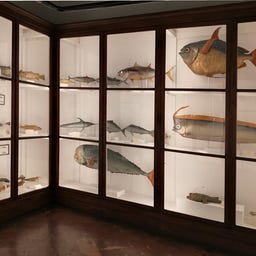
In the Palazzo Torrigiani, you will find one of the oldest natural history museums in Italy, founded in 1775 by Grand Duke Pietro Leopoldo. The impressive Salone degli Scheletri houses a remarkable collection of animal skeletons, including elephants and a humpback whale, while the world-famous wax model collection from the 18th and 19th centuries showcases anatomical models of unique quality.
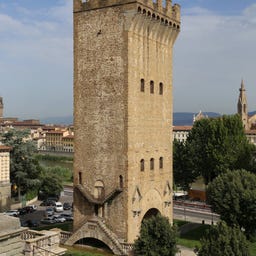
The impressive Porta San Niccolò is the only city gate of Florence that has retained its original height from the 14th century. This structure, likely designed by Orcagna in 1324, served to defend the eastern access to the Arno and has never been flattened thanks to the protective San Miniato Hill.
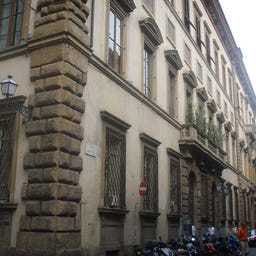
In the heart of Florence stands the impressive Palazzo Pucci, built between 1528 and 1534 under the guidance of Bartolomeo Ammannati. This Mannerist-style palace captivates with its long façade divided into three sections and three distinctive courtyards, the first of which is adorned with reliefs and a historical carriage from the 19th century.

The modern Tuscanyhall has been one of the most important cultural venues in Florence since 1978, accommodating up to 1,700 spectators in its distinctive tent structure. After several name changes and a major renovation in 2002, the theater has established itself as a versatile event location.
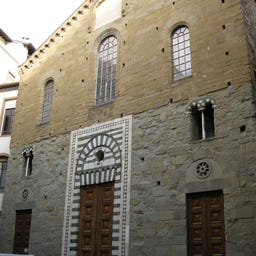
Right next to the famous Ponte Vecchio stands the Chiesa di Santo Stefano al Ponte, which has a history dating back to 1116. The church combines Romanesque architecture with later Gothic and Baroque influences and houses remarkable artworks, such as the bronze relief "Martyrdom of Saint Stephen" by Ferdinando Tacca.
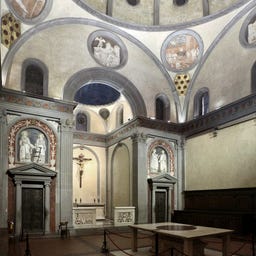
In the Basilica di San Lorenzo, you will find the Sagrestia Vecchia, an architectural masterpiece from the early 15th century, created by Filippo Brunelleschi between 1421 and 1428 as a mausoleum for the Medici family.
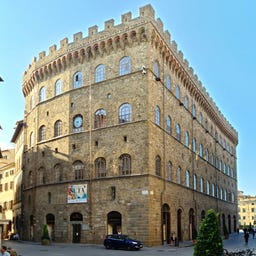
At the beginning of the elegant Via Tornabuoni, the imposing Palazzo Spini Feroni rises, which competed with the Palazzo Vecchio as the largest private palace in Florence at the end of the 13th century. This fortress-like building, with its distinctive battlements and visible masonry, still showcases the medieval architecture of the city and has housed the fashion house of Salvatore Ferragamo since 1938. In the opulent rooms, you will find not only the boutique but also the Museo Salvatore Ferragamo, which documents the history of the legendary shoe designer. Particularly worth seeing are the private chapel with frescoes by Bernardino Poccetti and the entrance atrium with its impressive high relief by Giuseppe Piamontini.

With its characteristic onion domes, the Russian Orthodox Church feels like a piece of St. Petersburg right in the heart of Florence. Initiated by Grand Duchess Maria Nikolayevna at the end of the 19th century, the church was built between 1899 and 1904 in the Russian Revival style and impresses with its elaborate design featuring Venetian mosaics and ceramic decorations.

On Lungarno Corsini stands the Palazzo Corsini al Parione, one of the most magnificent private palaces in Florence, built by the Corsini family, who rose to become the wealthiest family in the city in the 17th century, starting in 1656. The baroque palace impresses with its U-shape, the grand spiral staircase, and the artistically designed façade featuring elliptical windows and ornate terraces.
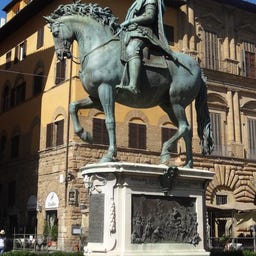
On the Piazza della Signoria, the first large equestrian statue of Florence stands tall - the bronze statue of Cosimo I de' Medici, the first Grand Duke of Tuscany. This impressive work was commissioned in 1587 by Ferdinando I and created by Giambologna, one of the most significant sculptors of his time, until 1594.

At the northern edge of Florence's historic center lies the Piazza della Libertà, known for its distinctive elliptical shape and covering an area of 10,000 m². The impressive Arco di Trionfo, built in 1738, commemorates the rise of the Lorraine dynasty following the end of Medici rule.

In the Biblioteca Medicea Laurenziana, you will find one of the most important manuscript collections in the world, originating from the private library of the Medici family. The library, designed by Michelangelo between 1519 and 1534, impresses with its unique Mannerist architecture, especially the narrow vestibule and the striking three-tiered staircase made of pietra serena.
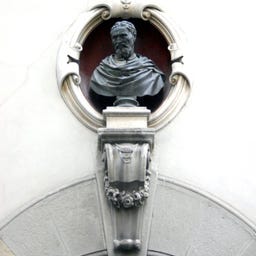
In this simple city palace, which Michelangelo acquired in 1508 and lived in intermittently until 1534, you will find today the most intimate of the Florentine artist museums. The rooms, lovingly arranged by his descendants, not only house the largest collection of his preparatory drawings in the world but also two of his early masterpieces: the "Madonna della Scala" and the "Battaglia dei centauri" from the early 1490s.
